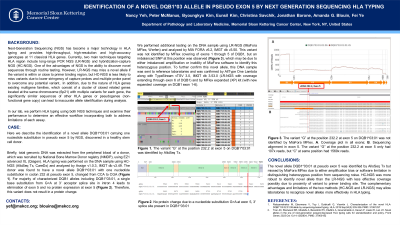Back

(P800) Identification of a novel DQB1*03 allele in pseudo exon 5 by next generation sequencing HLA typing
Location: Platinum Ballroom

Poster Presenter(s)
Body: Next-Generation Sequencing (NGS) has become a major technology in HLA typing and provides high-throughput and high-resolution genotypes. Currently, two main techniques targeting HLA region include long-range PCR NGS (LR-NGS) and hybridization-capture NGS (HC-NGS). One of the advantages of NGS is the ability to discover novel sequences. However, LR-NGS may miss a novel allele if the variant is within or close to primer binding region, but HC-NGS is less likely to miss variants due to lower stringency of capture probes. In our lab, we perform HLA typing using both NGS techniques.
Here we describe the identification of a novel allele DQB1*03:01 carrying one nucleotide substitution in pseudo exon 5 by NGS, discovered in a healthy stem cell donor. HLA typing was performed using HC-NGS (AlloSeq Tx, CareDx) and analyzed by Assign v1.0.3, IMGT db v3.49. The donor was found to have a novel allele DQB1*03:01 with one nucleotide substitution in codon 232 at pseudo exon 5, changed from CCA to CGA (Figure 1). For most DQB1 alleles including DQB1*03:01, a G>A at acceptor splice site in intron 4 leads to no expression at exon 5. Therefore, this variant does not result in a protein change. We performed additional testing using LR-NGS (MiaFora MFlex, Werfen). This variant was not identified by MFlex covering exon 1-5 of DQB1, but an imbalanced SNP at this position was observed (Figure 2), which may be due to either imbalanced amplification or inability of MiaFora software to identify this heterozygous position. To further confirm this novel allele, the sample was sent to reference laboratories, and was confirmed by AllType One Lambda (LR-NGS with coverage extending through exon 6 of DQB1) and by MFlex expanded (XP) kit (with new expanded coverage on DQB1 exon 1-6).
Conclusion: The novel allele DQB1*03:01 at pseudo exon 5 was identified by AlloSeq Tx but missed by MiaFora MFlex due to either amplification bias or software limitation in distinguishing heterozygous position from sequencing noise. HC-NGS was more robust to identify novel allele than the LR-NGS with less effective coverage possibly due to proximity of variant to primer binding site. The complementary advantages and limitations of the two methods (HC-NGS and LR-NGS) may allow laboratories to recognize novel alleles more effectively in HLA typing.
Here we describe the identification of a novel allele DQB1*03:01 carrying one nucleotide substitution in pseudo exon 5 by NGS, discovered in a healthy stem cell donor. HLA typing was performed using HC-NGS (AlloSeq Tx, CareDx) and analyzed by Assign v1.0.3, IMGT db v3.49. The donor was found to have a novel allele DQB1*03:01 with one nucleotide substitution in codon 232 at pseudo exon 5, changed from CCA to CGA (Figure 1). For most DQB1 alleles including DQB1*03:01, a G>A at acceptor splice site in intron 4 leads to no expression at exon 5. Therefore, this variant does not result in a protein change. We performed additional testing using LR-NGS (MiaFora MFlex, Werfen). This variant was not identified by MFlex covering exon 1-5 of DQB1, but an imbalanced SNP at this position was observed (Figure 2), which may be due to either imbalanced amplification or inability of MiaFora software to identify this heterozygous position. To further confirm this novel allele, the sample was sent to reference laboratories, and was confirmed by AllType One Lambda (LR-NGS with coverage extending through exon 6 of DQB1) and by MFlex expanded (XP) kit (with new expanded coverage on DQB1 exon 1-6).
Conclusion: The novel allele DQB1*03:01 at pseudo exon 5 was identified by AlloSeq Tx but missed by MiaFora MFlex due to either amplification bias or software limitation in distinguishing heterozygous position from sequencing noise. HC-NGS was more robust to identify novel allele than the LR-NGS with less effective coverage possibly due to proximity of variant to primer binding site. The complementary advantages and limitations of the two methods (HC-NGS and LR-NGS) may allow laboratories to recognize novel alleles more effectively in HLA typing.

